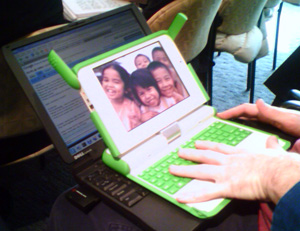
I was studying Ceramics in Cardiff and becoming aware that there was a thing out there called the 'Internet'. It was something that was accessable on one admin PC in the college office and no one had email addresses, after all, it was an Art college, what would artists need internet access for?
I was also reading a lot about women and technology, for my dissertation. I was particularly taken by the writings of
Matilda Joslyn Gage and
Donna Haraway's '
Cyborg Manifesto'. Gage argued that women have been involved in technology since the beginning but that their achivements had been obscured by the men who wrote the history. Haraway used the idea of a Cyborg a human/machine hybid, creature of social reality/fiction, as what I read as a call for feminist engagement with technology rather than just an analysis of it from the margins,
'I would rather be a cyborg than a goddess' resonated with me.
I came across a snippet in a book about Gage being the mother-in-law of L Frank Baum, and her being the one who encouraged him to write the stories, which are echoed
here. When I discovered the
Patchwork Girl of Oz. I wondered if Scraps
creation myth had been an influence on Haraway's construction of her cyborg. After all, the Oz stories were modernist fairy tales and, from my understanding, culturally much more significant in the USA than they were here (I also read that there was a move to ban some of the books from libraries at the height of the cold war hysteria, it was claimed that they were 'unwholesome for young minds').
I had no email, but I had discovered Haraway's email address on a public access PC in Cardiff. One of the women in college with had a boyfriend who worked in IT, and she volunteered his services. I wrote out my question on piece of paper and gave it to her, she gave it to him and the following morning I was presented with a print out of her reply, the substance of which was:
No, The Cyborg had been based primarily on the character of Connie in
Marge Piercy's 'Woman on the edge of time', that she had forgotten all about Scraps, but could see what I thought that.
Although I neither typed or clicked on send, it was my first experience of email and I was delighted. I am wary of what seems to be a push towards videoconferencing in education at the moment. I think it's easy to overlook the power for plain text. And, I think that it serves as an object lesson in how institutions are often behind the learning curve. Technology doesn't have to be complex to be empowering.

















